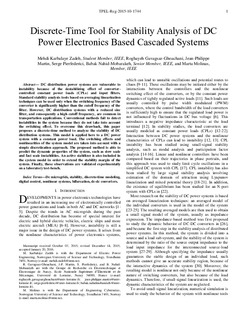| dc.contributor.author | Zadeh, Mehdi Karbalaye | |
| dc.contributor.author | Gavagsaz-Ghoachani, Roghayeh | |
| dc.contributor.author | Martin, Jean-Philippe | |
| dc.contributor.author | Pierfederici, Serge | |
| dc.contributor.author | Nahid-Mobarakeh, Babak | |
| dc.contributor.author | Molinas Cabrera, Maria Marta | |
| dc.date.accessioned | 2018-01-23T09:10:34Z | |
| dc.date.available | 2018-01-23T09:10:34Z | |
| dc.date.created | 2018-01-19T23:57:00Z | |
| dc.date.issued | 2017 | |
| dc.identifier.issn | 0885-8993 | |
| dc.identifier.uri | http://hdl.handle.net/11250/2478943 | |
| dc.description.abstract | DC distribution power systems are vulnerable to instability because of the destabilizing effect of converter-controlled constant power loads (CPLs) and input filters. Standard stability analysis tools based on averaging linearization techniques can be used only when the switching frequency of the converter is significantly higher than the cutoff frequency of the filter. However, dc distribution systems with a reduced size filter, and consequently a high cutoff frequency, are common in transportation applications. Conventional methods fail to detect instabilities in the system because they do not take into account the switching effect. To overcome this drawback, this paper proposes a discrete-time method to analyze the stability of dc distribution systems. This model is applied here to a dc power system with a CPL. The switching effects and the nonlinearities of the system model are taken into account with a simple discretization approach. The proposed method is able to predict the dynamic properties of the system, such as slow-scale and fast-scale instabilities. An active stabilizer is also included in the system model in order to extend the stability margin of the system. Finally, these observations are validated experimentally on a laboratory test bench. | nb_NO |
| dc.language.iso | eng | nb_NO |
| dc.publisher | Institute of Electrical and Electronics Engineers (IEEE) | nb_NO |
| dc.title | Discrete-Time Tool for Stability Analysis of DC Power Electronics-Based Cascaded Systems | nb_NO |
| dc.type | Journal article | nb_NO |
| dc.type | Peer reviewed | nb_NO |
| dc.description.version | acceptedVersion | nb_NO |
| dc.source.volume | 32 | nb_NO |
| dc.source.journal | IEEE transactions on power electronics | nb_NO |
| dc.source.issue | 1 | nb_NO |
| dc.identifier.doi | 10.1109/TPEL.2016.2526740 | |
| dc.identifier.cristin | 1548011 | |
| dc.description.localcode | © 20xx IEEE. Personal use of this material is permitted. Permission from IEEE must be obtained for all other uses, in any current or future media, including reprinting/republishing this material for advertising or promotional purposes, creating new collective works, for resale or redistribution to servers or lists, or reuse of any copyrighted component of this work in other works. | nb_NO |
| cristin.unitcode | 194,64,20,0 | |
| cristin.unitcode | 194,63,25,0 | |
| cristin.unitname | Institutt for marin teknikk | |
| cristin.unitname | Institutt for teknisk kybernetikk | |
| cristin.ispublished | true | |
| cristin.fulltext | preprint | |
| cristin.qualitycode | 2 | |
